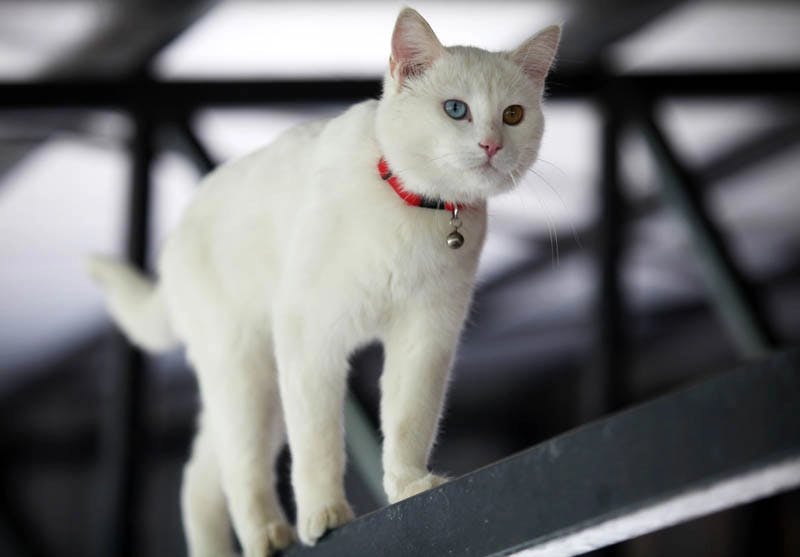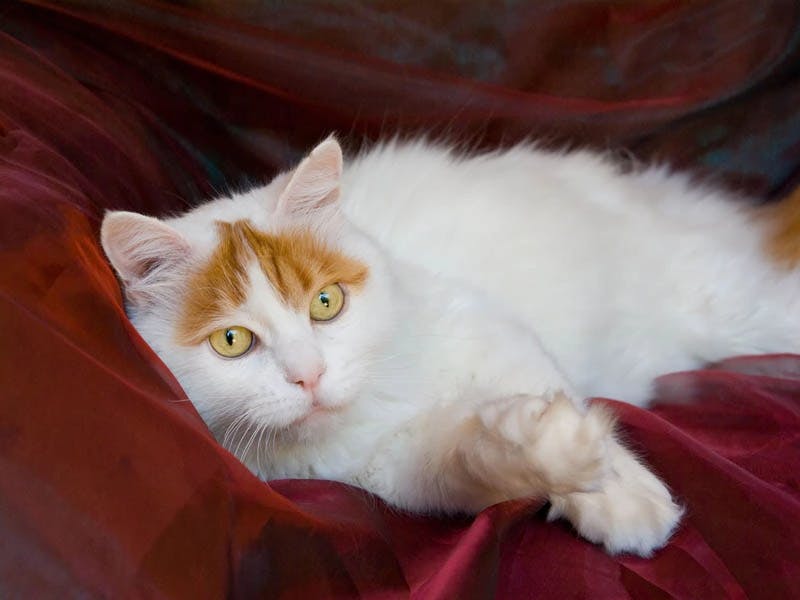Turkish Van
A Very Rare Cat Who Loves to Swim
Turkish Van
Jon Crimes - Last Updated on December 18th, 2021
What you Need to Know about the Turkish Van
The Turkish Van is a large muscular cat with broad shoulders and a commanding appearance. Although slow to mature, when they reach full adult growth, they turn into one of the largest cat breeds.
Turkish van cats are not known for being lap cats. These are felines that prefer to keep all their paws on the ground. They are full of affection and like an occasional cuddle.
If you feel your 'van' rubbing against your leg, then it could be time for some stroking.

Appearance Matters. What does a Turkish Van look like?
The Turkish Van is a long-haired domestic cat breed that is considered to be rare. Their appearance is most noticeably by the van color pattern. The majority of the cat's coat is white. The exception being colors limited to their head and tail. These unusual color patterns are developed by the breed's unique piebald spotting gene.
Male Turkish Van's can weigh 16 pounds while females are slightly smaller at around 14 pounds.
They can also measure up to 3 feet in length.
Turkish Van Colors
These 'van' colors on their head and tail can include:
- Red
- Cream
- Black
- Blue
- Tabby
- Tortoiseshell
- Blue-cream
These are some of the most common colors. But providing the rest of the body remains white, then most colors are accepted for the Turkish Van breed. Turkish Van kittens will generally have these patterns from an early age. Fully-grown cats will show the same colors.
What is the difference between Turkish Van and Turkish Angora?
These cats can look very alike, but Turkish Vans have white bodies, apart from the head and tails. Turkish Angora can have various body colors. Being that they are both long-haired cats and of a similar size, the confusion is understandable.
Another unusual appearance trait is the breed’s relation with religion. Breeders in Turkey strive to produce cats that have a rather unique 'thumbprint of god' pattern on their shoulders. Muslims highly respect these colored patches. They consider the cats to be blessed by God.
The cat's eyes can be blue or amber. They can also have 'odd' eyes, meaning that they have eyes of different colors.
Their long-hair has the texture of rabbit fur. They also have a thick neck ruff and long bushy tail. Large paws and long, strong legs complete the look of this impressive feline.
It's all Personal. The Turkish Van Personality
The Turkish Van cat personality is one of exuberance and full of energy. They are famous for making their owners jump at the most unexpected moments, especially when something gets their attention.
These large cats also impress with their intelligence and inquisitive 'conversation'. When they think it's time to eat, or they want to go outside and explore, they'll let you know.
If you want a cat that likes to be quiet and stay out of the way, then the Turkish Van is probably not for you. If you have other larger pets, then be aware the Turkish Van likes to dominate and show its bossy side. They love to be the alphas in any household.
Although with their massive paws and limbs, they can appear clumsy, you'll be surprised at how high they can jump. This helps them to get up to all sorts of mischief. Think of opening doors, cabinets, and windows.
Their agility has led to them being described as feline trapeze artists.
They are also known for being very assertive and will defend themselves from real and imaginary attacks. They do enjoy the presence of other cats. However, they will get on better with other 'lively' felines and, in particular, other Turkish Vans.
Do Turkish Van cats like to swim?
It won't be long before you see a Turkish Van cat swimming! These cats love water, a trait that is probably because their original homeland can get quite hot.
Most cats hate getting wet. But the Turkish Van has a coat that actually repels water, making the experience more pleasurable for them. They absolutely love to cool off!
When they haven't got access to places where they can swim then expect your cat to have other fascinations. This might include a strong interest in the toilet bowl or even leap into the bathtub.

Caring for your Turkish Van
The Turkish Van has a long soft coat that sheds quite heavily twice a year. They need regular brushing. Weekly grooming is advised to keep their coat tangle-free. This will also help to eliminate the possibility of any mats forming.
Their facial hair is very short, but you would need to pay attention to the fur around their neck. Pay particular attention to their big bushy tails. When they have their winter coat, they also groom around their ears, legs, and around their belly. Start this brushing routine at an early age if possible.
Is the Turkish Van cat hypoallergenic?
No. This breed is not hypoallergenic. If you suffer from cat allergies caused by fur dander, then you might want to consider another breed.
You shouldn't need to bathe your Turkish Van unless they go swimming somewhere they shouldn't. If bathing is required, then towel dry only. Using a hairdryer can harm the natural oils in their coats.
There are some activities to build into your grooming routine. Check and clip their nails when required. Also, wipe away any dirt from their ears or discharge from their eyes with a soft, damp cloth.

The Health and Happiness of your Turkish Van
The Turkish Van has no known inherited health conditions. They are generally considered to be a very healthy breed. Apart from some of the more usual conditions which might affect all cats, there is something else to be aware of.
These are big cats who will really benefit from being kept lean and healthy. Monitoring their food intake and activity levels are vital in preventing some common obesity-related problems. These conditions can include cat diabetes, heart disease, and arthritis.
What is the Turkish Van cat lifespan?
A healthy Turkish Van cat can expect to have a lifespan of between 12 and 15 years.
Where Can I Find the Best Turkish Van Breeders?
It can be tricky to find the best breeders for your cat. This is especially true if it is a rare breed such as the Turkish Van.
We can help you with this predicament, though. You can take a look at our list of the best Turkish Van breeders to find the one that suits you best. The price of these kittens is around $1,000.
You definitely should get your pets from reputable breeders because that will help you avoid many problems in the long run. This is especially true when it comes to the health of your pet.
Feline History. Where does the Turkish Van come from?
This cat originates from Turkey, near Lake Van. They are surrounded by folklore tales and mystery. One story even dates back to the time of Noah's Ark, some 5,000 years ago.
These stories are also accompanied by the depiction of similarly shaped cats in ancient artwork. Together they suggest that the Turkish Van might be one of the oldest cat breeds in existence.
More modern efforts to breed this cat started in 1955. These programs found that the cat was ideal for breeding. They have little or no deviation from their true lineage.
In 1969, the Turkish Van was awarded pedigree status by the GCCF.
The CFA accepted the cat for registration in 1988, and the showing of this breed began in 1994

